Home > About Us > Blog > Blog > Different Types of Walkers
Sep. 24, 2021
Whether it is due to joint pain, balance problems, fatigue, or any other condition, mobility can be a major issue for many of us as we get older. Thankfully, a walker or a rollator can significantly enhance your ability to get up and around. Walkers are very useful mobility aids, designed to help people who need extra support and stability. However, like all mobility aids, they come with a price tag, which begs the question. All walkers on the market today can be divided into three different types, namely: standard walkers wheeled walkers, or rollator walkers.
If you are strapped for cash or if you only need a walker for a short period of time, then a standard walker is usually the best choice. Standard walkers are the most common choice for people who are financially savvy or looking for something simple. In terms of design, the standard walker has a unique U-shaped frame designed to create greater clearance - allowing for ease of movement while maintaining balance and support.
However, as conventional walkers require the user to lift the device manually in order to move, they are best used primarily for short distances. They are also a good option if you only want to use the walker indoors.
Reciprocal Walker with Single Release
While traditional walkers do not have wheels and all four legs are on the ground, wheeled walkers usually have two front wheels. These wheels make it easier to move the device, while often sacrificing some balance and support in exchange.
Unlike standard models, two-wheeled walkers are an excellent choice for outdoor use as they are easier to move over rough surfaces and uneven terrain. However, as mentioned above, if you experience balance problems - the loss of stability that comes with the wheels may not be worth it.
That said, it's worth noting that most wheeled models come with wheel locks, which do go some way to alleviating any stability issues. So if balance is not a major issue for you and you want a more maneuverable walker, then a wheeled model may be a good choice. But of course, it is important to remember that they are usually more expensive than models without wheels.
If two wheels still aren’t enough for you, you may want to consider joining one of the many people opting to use a rollator instead! Rollators are another type of walker that have only wheels touching the ground, rather than static legs. There are two main types of rollators, and both types tend to cost a fair bit more than the previously discussed styles:
Three-wheeled rollators are usually narrow and designed to provide extra independence for people who need to move smoothly in tight spaces and suffer from mobility problems. They are easier to use than standard lift and push walkers as the frame only needs to be pushed, not lifted. They have three cleverly placed wheels (two at the back and one at the front) which allow the user to navigate easily.

Rollator
They are best suited to people who need some extra balance and support but do not require the full support provided by a Four-wheeled rollator walker. By design, most of these models are lightweight and portable; making them very easy to use both outdoors and indoors.
Despite their relatively high price, Four-wheeled rollator walkers are probably the most popular models of mobility aids on the market. They offer full support to anyone who wishes to maintain mobility and independence without the need for effort. With their wide base, four points of contact with the ground, and the usual seat and backrest, they are a fully functional option. Four-wheeled rollator walkers allow any user to get around easily and efficiently while resting when necessary.
Of course, with 4 wheels, a walker aid will never be as stable as a 2-wheel or standard walker. The brakes can be locked, but sometimes this is not enough to ensure the user feels safe, especially if they have balance or mobility issues.
How much a walker cost depends on the type of walker or rollator you require, the features you want, and whether the walker may be subsidized by medicare or insurance. But ultimately, you can find a reliable, high-quality model with standard features from as low as $50. If you want something better, you might need to increase your budget. However, at the end of the day, it’s hard to put a price on the freedom, independence, and quality of life improvements a good walker can bring.
Genteel is a professional manufacturer dedicated to designing, developing, and producing rehabilitation medical equipment specializing in rollators, walkers, patient lifts, shower chairs, home-care beds, and crutches. If you want to get more information about mobility aids for sale, please contact us.